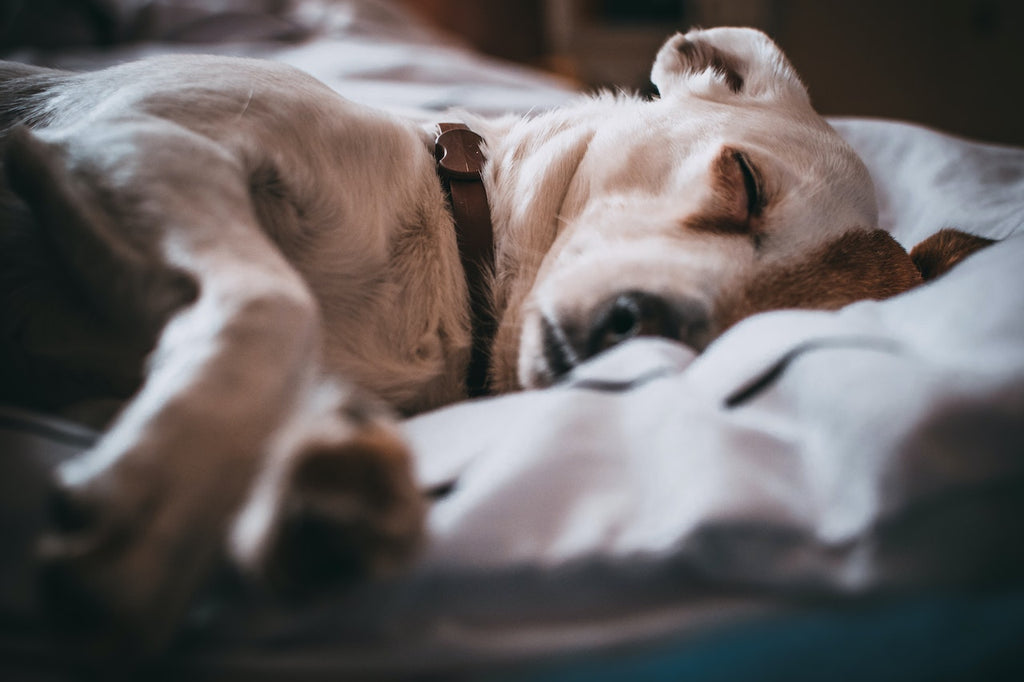Is your dog getting a good night’s sleep? Well, for some pets that could mean sleeping day and night. Depending on the dog, quality of sleep can be even more important than quantity. Smaller animals, which often have higher rates of brain metabolism, tend to require more sleep, while larger animals generally get less. Herbivores and land-grazing animals use so much time eating they don't have much time left for sleep.
A lot of research is spent studying sleep patterns in animals. "The only way to understand human sleep is to study animals," says Jerome Siegel, PhD, professor of Psychiatry at the UCLA Center for Sleep Research. "If we could better understand animal sleep, we could better understand the core aspects of sleep."
Rapid eye movement (REM) and the brain wave pattern during REM sleep are similar in animals and humans. REM is the state that is associated with dreams. Both humans and all other mammals display the same level of brain activity and increased heart rate variability during REM. You have probably seen your dogs bark or twitch their legs while sleeping. That is REM.
Then there’s the biological clock. Much of the sleep pattern – feeling sleepy at night and awake during the day – is regulated by light and darkness. Light - strong light, like bright outdoor light (which is brighter than indoor light even on cloudy days) - is the most powerful regulator of a body’s biological clock. The biological clock influences when one feels sleepy and when one feels alert. As a result, finding the balance of light and darkness exposure is important.

FACTORS THAT AFFECT QUALITY AND NATURAL WAYS TO IMPROVE SLEEP:
- Light – For diurnal creatures light during the day sets the internal clock for the night’s rest and repair. Make sure to expose yourself and your dog to enough bright light during the day. Find time for sunlight, take the dog for a walk or ride the horse. Then before bedtime start dimming the lights in the house so that by bedtime all is dark.
- Noise – Animals are even more tuned in to changes in sounds around them than humans are. Avoid a lot of commotion when it’s bed time.
- Temperature – Better to be a little cooler than too hot. The internal thermostat lowers as sleep ensues so a bit cooler environment will accommodate that natural effect.
- Age - Along with the physical changes that occur as everyone gets older, changes to sleep patterns are a part of the aging process. The older one gets the harder it can be to fall asleep and more trouble staying asleep than when they were younger. However, sleep needs remain constant throughout one’s life. Medical problems and physical illnesses tend to increase with age and the effects of medication on the body can further aggravate disorder.
- Arthritis can make it difficult to get comfortable and then stay asleep. Cognitive dysfunction in dogs typifies disorders in the elderly.
- Surface – Nobody likes to be cramped. This includes your furry best friend. It is clear that the bed surface plays a role in getting a good night's sleep. The bed needs to provide good support. Research on patients with back pain found a supple comforting mattress may lead to better sleep. If your dog has allergies you may also wish to purchase hypo-allergenic covers designed to protect from possible allergic triggers such as the dust mite.
- Exercise - Depending on your dogs health status, providing physical activity is a great way to tire them out. Mental activity could assist in sleeping as well.
- Your pup loves a good foot rub just as much as us! Learn the 5 relaxing benefits of giving your pup a spa day!
- An optimal diet and managing stress can help a dog live a balanced life with proper energy for exercise and play time as well as knowing when it's time to take a rest.
These tips may help you and or your partner! If your partner is an English Bulldog or a Pug, well we may need to write a blog post on snoring. Sweet dreams!



Leave a comment: